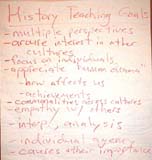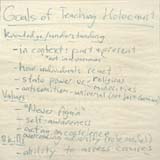 title slide |
 organization of talk |
 ask teachers to write, then put on butcher paper; then show second bullet with state standards (image) |
 collect the teachers' goals |
 Ask the teachers what their goals are for this material in particular; 2nd bullet uses state standards categories |
 Collect the goals the teachers named |
 Let's look at the means we have at our disposal to achieve these goals |
 warm-up before looking at how a museum tries to achieve these goals (write on index cards) |
 some of the actual cards (see my on-line article describing the museum) |
 collected on easel: note the top 3, by a teacher who'd visited at least 6 times! |
 Let's categorize the memories: did anyone remember any goals? (yes! the 3 at the top, but that was an exception) |
 Goal of "The Manipulator"? to make us feel uncomfortable with prejudices |
 Goal of the doors? Force us to see prejudice in ourselves |
 Goal of globalhate.com? To show that hate is "out there" now. |
 Goal of interactive diner? Think about responsibility |
 Goal of civil rights videos? Examples of taking action. |
 Goal of genocide video? Consequences of hate. |
 Now to go back and see a historical example... |
 very (too) sophisticated: the exhibit is constructed |
 Cafe: slick multimedia scene with individual stories |
 Tension between "ordinary people" and "ordinary Germans" |
 Wannsee Conference mock-up: marks historical turning point physically |
 ID cards: this simple exhibit is very memorable. Goal: to personalize |
 Camp gate/selection doors. Goal: experience the choice people had to make |
 Hall of testimony. Goal: shock with graphic stories in 'gas chamber'? |
 Artifact collection upstairs. Goal: satisfy hunger for connection to "real" history |
 Quotations throughout the exhibits. Goal: make goals explicit? |
 Did museum achieve its goals? Our goals? |
 Did it achieve its goals? |
 Is "tolerance" an appropriate goal? (scan of cartoon) |
 Activity: divide into pairs and assess for 10 mins. |
 These are the features to look for. But: in follow-up ask who noticed goals . |
|
|
 Another model that I develop and apply in my Holocaust courses. (Draws on "people" in previous.) (image alone, from my Hist 33D course, Lecture 14) |
 Didn't show this because of time; would have served as basis for discussion of root causes. |
 My personal conclusions: Holocaust is better for teaching historical research and assessment skills. Don't try to teach values--better to let students learn them for themselves. |
back to top, to workshop main page, to H. Marcuse homepage
